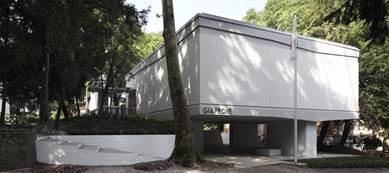Venice Biennale Japan Pavilion The first renovation work in 50 years is completed.

1. Front view of the renovated Japan Pavilion ©Peppe Maisto
The first full-scale renovation of the Venice Biennale Japan Pavilion since it was constructed has been completed, and the pavilion will reopen in all its new glory at the 14th International Architecture Exhibition - La Biennale di Venezia in June.
The Japan Pavilion was completed in 1956, thanks to funds provided by Mr. Shojiro Ishibashi (founder of the Bridgestone Corporation) which covered a large part of the costs involved. The unique structure designed by Takamasa Yoshizaka, who studied under Le Corbusier, has been used in all subsequent biennales as the venue for the exhibition of work by the artists representing Japan, and has been operated since 1976 by the Japan Foundation.
During the past 50 years, the Pavilion had undergone partial renovation on several occasions, but the fact that the building as a whole was progressively deteriorating and that it was now required to accommodate a variety of different exhibitions that were never envisaged at the time of its construction meant that the prompt implementation of renovation work had become a pressing issue.
In view of the circumstances, the Ishibashi Foundation (Hiroshi Ishibashi, President) provided a grant for the renovation of the Pavilion, and commissioned architect Toyo Ito to carry out the project.
The successful completion of this renovation, the focus of which was on restoring the building to the greatest extent possible to the state it was in at the time of its initial construction, opens a new chapter in the history of the Japan Pavilion in its role as a point of dissemination for the art and culture of Japan.
Comment by Toyo Ito
Designed by Yoshizaka Takamasa, the Venice Biennale Japan Pavilion was an ambitious work, a forerunner of post-war Japanese Modernist architecture that has played a major role in the dissemination of Japanese architecture and art to the rest of the world.
However, the frequent renovations and refurbishments carried out during the 58 years since its construction have caused the pavilion to deviate considerably from its initial design. At the request of the Ishibashi Foundation, I had the honor of being involved in the renovation of the pavilion, which included restoring Mr. Yoshizaka's original design to the greatest possible extent. That we were able to recover the original appearance of the pavilion, in particular by the restoration of the garden and the introduction of natural light from the roof was, I think, a superb achievement.
Toyo Ito
La Biennale di Venezia
The Venice Biennale is an international arts festival in which works are exhibited in various different venues across the island city of Venice, Italy. The Biennale has a history of more than 120 years, having opened its first art exhibition in the year 1895. In recent years, international art festivals have sprung up around the world, but the Venice Biennale is the most prestigious of them all, becoming a template for other international art festivals. It is currently divided into a number of stand-alone segments (the Art Exhibition, the Architecture Exhibition, the Music Festival, the Film Festival, the Theatre Festival, and so on), and in recent years the Art Exhibition and the Architecture Exhibition have been held on alternating years. Inside the Giardini, one of the main venues for the Art Exhibition, there are pavilions from 30 countries, mainly from Europe and North America, and the many other countries participating in the Biennale exhibit in other venues around the city. It is not only tourists who visit Venice during Biennale season. It is gathering place for people associated with the worlds of art and architecture, the press and the diplomatic corps, turning Venice into a bustling place of information exchange and social interaction. On each occasion, about 30 million people visit the Art Exhibition and about 15 million, the Architecture Exhibition.
Ishibashi Foundation
Founded by Shojiro Ishibashi (founder of the Bridgestone Corporation and widely involved in cultural enterprises), the Ishibashi Foundation operates on two pillars: its art museum activities represented by the Bridgestone Museums of Art in Kyobashi, Tokyo and the Ishibashi Museum of Art in Kurume, Fukuoka Prefecture; and its endowment and its grant programs, which support art, culture and education activities.
[Contact Us]
The Japan Foundation
Europe, Middle East and Africa Section, Arts and Culture Dept.
Person in charge: Mori (Ms.)
Tel: +81-(0)3-5369-6063
Fax: +81-(0)3-5369-6038
Email: venezia@jpf.go.jp
(When sending an e-mail, please enter a half-width character "@" instead of a full-width character "@.")
- What We Do Top
- Arts and Cultural Exchange [Culture]
- Japanese-Language Education Overseas [Language]
- Japanese-Language Education Overseas [Language] Top
- Learn Japanese-language
- Teach Japanese-language
- Take Japanese-Language Test
- Know about Japanese-language education abroad
- The Japanese-Language Institute, Urawa
- The Japanese-Language Institute, Kansai
- Japanese-Language Programs for Foreign Specified Skilled Worker Candidates
- Japanese Language Education for Japanese Children Resident Overseas and for the Descendants of Migrants
- Archives
- Japanese Studies and Global Partnerships [Dialogue]
- JF digital collection
- Other Programs / Programs to Commemorate Exchange Year
- Awards and Prizes
- Publications
